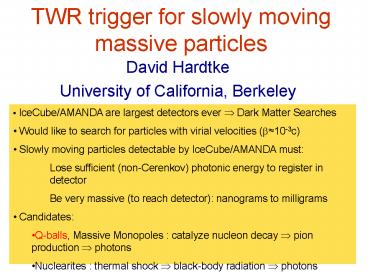TWR trigger for slowly moving massive particles
1 / 15
Title:
TWR trigger for slowly moving massive particles
Description:
IceCube/AMANDA are largest detectors ever Dark Matter Searches. Would like to search for particles ... TWR set up for software triggering this austral summer ... –
Number of Views:30
Avg rating:3.0/5.0
Title: TWR trigger for slowly moving massive particles
1
TWR trigger for slowly moving massive particles
- David Hardtke
- University of California, Berkeley
- IceCube/AMANDA are largest detectors ever ? Dark
Matter Searches - Would like to search for particles with virial
velocities (?10-3c) - Slowly moving particles detectable by
IceCube/AMANDA must - Lose sufficient (non-Cerenkov) photonic energy to
register in detector - Be very massive (to reach detector) nanograms to
milligrams - Candidates
- Q-balls, Massive Monopoles catalyze nucleon
decay ? pion production ? photons - Nuclearites thermal shock ? black-body
radiation ? photons
2
Experimental Challenge
- Detector Traversal Times (?d 500 m)
- Muon-DAQ ? 10 ?s live, 1 ms dead
- SN system ? No tracking
- Dark Noise Rate 1 kHz
Need Online Topological Trigger
3
Standard TWR trigger
- TWR team plans to implement two trigger types
- Multiplicity trigger (similar to muon DAQ)
- Volume Local Coincidence Trigger (NEXT Trigger)
- Both triggers count hits in 10 ?s window
High Threshold -- write Out multiplicity event
Low Threshold -- check For local coincidences
4
? 10-3
- At virial velocites, the particle moves 0.3 m/?s
- Typical AMANDA inter-module spacing on string is
10-20 m (30-70 ?s) - Typical AMANDA inter-string spacing is 30-60 m
(100-200 ?s) - Must assume that any dark matter yields have low
light yield (otherwise, not good Dark Matter
candidates)
Volume Local Coincidence concept will work, but
need larger time windows searched.
5
? 10-3
- KKST Q-ball prediction for MQ1018 GeV/c2
- 100 GeV/cm in pions (? -gt Cerenkov light)
- Total Energy deposited in detector 106 GeV
- TeV/?s (looks like series of low energy
cascades) - dE/dx MQ 2/3
- Theoretical Optimism ? Expect lower energy
deposited - Monopoles look similar (Rubakov mechanism)
6
Trigger Scheme
- More than N hits in 10 us window
- Prepare list of modules hit in time window
- Check for Local Coincidences
- Examine many consecutive time windows, look for
particle moving with target velocities
(5x10-4lt?lt10-2)
7
Schedule
- TWR set up for software triggering this austral
summer - Next year -- use simulations and random triggered
TWR data to optimize trigger - Velocity search range
- Local coincidence threshold
- Online cross-talk filtering?
- Fast search algorithm
- Might need slight change in TWR trigger scheme
(data buffering) -- also required for
IceCube-Amanda common triggering - Goal for December 2005 Implement
astrophysically interesting trigger that does
not impact neutrino data rates (aim for few of
bandwidth)
8
Physics Potential
9
Conclusions
- TWR allows AMANDA searches for slowly moving
massive particles - Negligible impact on core physics program
- Similar algorithm will be ported to IceCube
- IceCube better for larger (rarer) objects
- AMANDA better for smaller objects that produce
less light
10
Nuclearites
- At very large quark (baryon) number, strange
quark matter with uds may be absolutely stable - Interior of neutron stars
- Nuggets produced in neutron star collisions or
during early universe - Characterized by Z/A ltlt 1/2
- Large mass nuclearites have nuclear densities
(?0.15 GeV/fm3) but atomic dimensions (Rgt1 A) - May be visible in IceCube/Amanda via
thermodynamic shock mechanism
11
De Rujula - Glashow Mechanism
- Macroscopically large (atomic dimension) massive
particles induce expanding cylindrical thermal
shock wave ? Blackbody Radiation - For atomic dimension objects at virial
velocities, T can reach several thousand Kelvin - Total Energy Loss
- Energy in visible photons
12
What is a Q-ball?
- Coherent state of squarks, sleptons, and Higgs
field - Non-topological Soliton ( Solitary Wave)
- Scalar field ? carries conserved charge Q (baryon
, lepton , etc.) - Potential U(?) has local minima at non-zero ?
Q-ball
13
Q-balls and baryogenesis
- One baryogenesis model Scalar (Affleck-Dine)
condensate formed - The condensate can have non-zero baryon-lepton
number if potential is flat - As temperature drops, symmetry broken, but lumps
of condensate (B-balls) survive. Other parts of
condensate decay to baryons
14
Q-balls properties
- MsSupersymmetry Breaking Scale (100-1000 GeV)
- Q-Balls stable for MQ gt1014 GeV
- Lifetime for MQ lt 1014 GeV unknown
15
Q-ball detection
- SENS (Supersymmetric Electrically Neutral
Soliton) - Q-ball catalyzes nucleon decay producing pions
- Similar to Rubakov monopoles, but larger
cross-sections - 100 GeV g-1 cm2
- IceCube can improve flux limits by 1-3 orders of
magnitude (exact number depends on MS) - SECS (Supersymmetric Electrically Charged
Soliton) - dE/dx 100 GeV/cm, but no Cerenkov light
- Glashow-DeRujlia mechanism may work for very
large MQ - Mica Limits probably always superior































